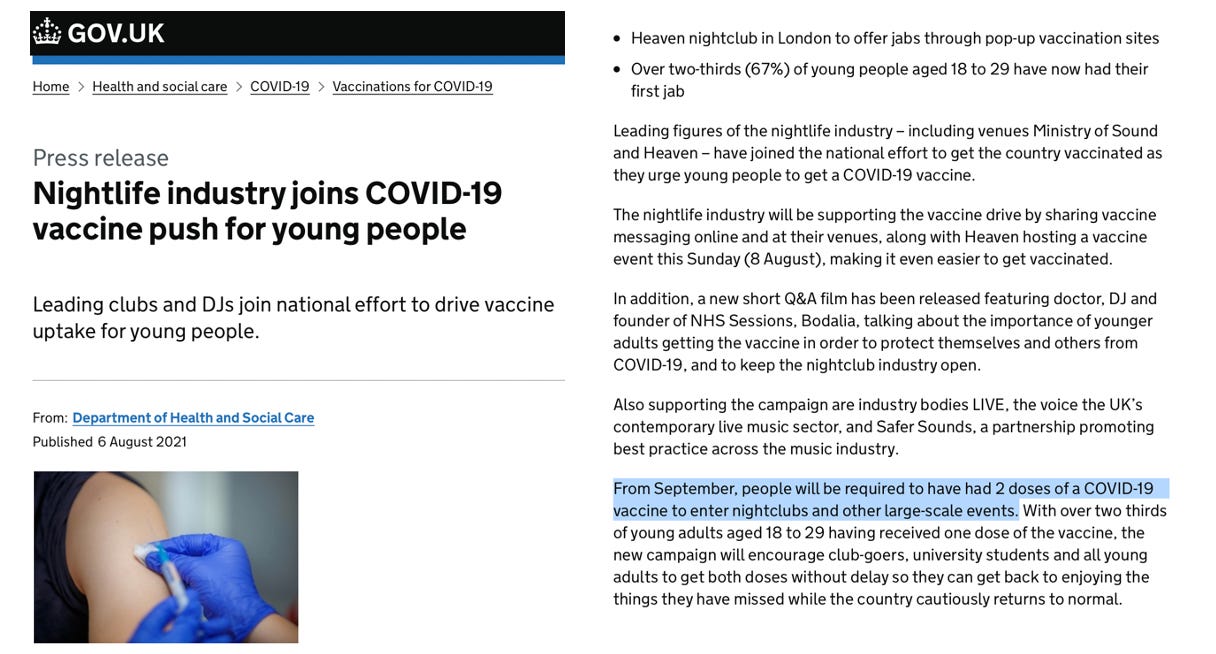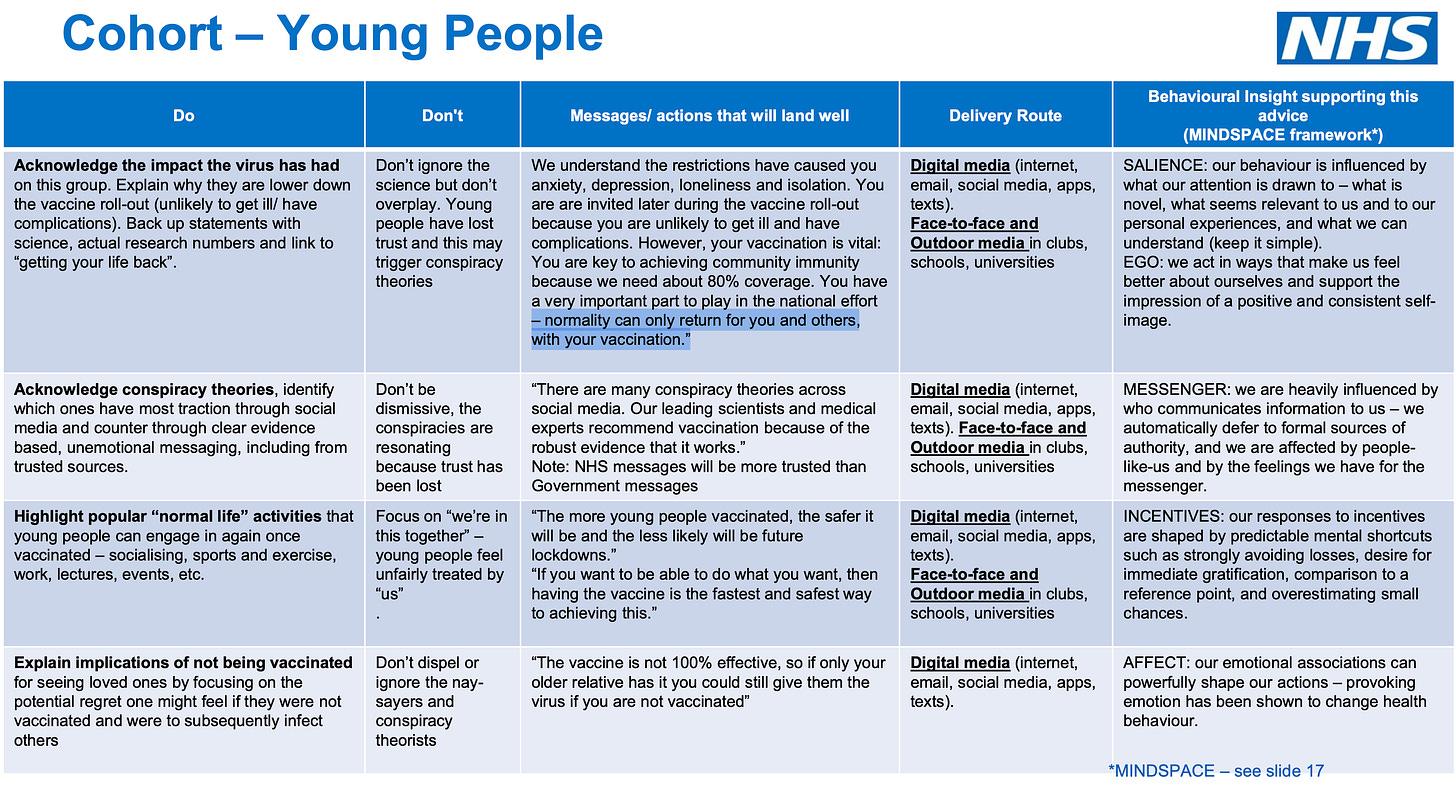[V] Exposing the UK Covid-19 Inquiry (Module 4)
Part V: covid vaccines and the illusion of benefit; MHRA and the reluctance to withdraw unsafe medical products; covid vaccine inducements for children; blood clots and cancers rose sharply...
Further to this post…
…and parts [II], [III] and [IV]…
…in which the purpose was to convey a flavour of what has been going on during Module 4 of the UK Covid-19 Inquiry…
Below are four further short videos along with transcripts.
V-1. Covid vaccines and the illusion of benefit [link]
Contributor: Dr Clare Craig, diagnostic pathologist and Co-Chair of HART
[Emphasis added]
The models assumed a never-ending tsunami of infection and death without lockdowns and vaccines. Numerous subsequent waves have disproved that. The models assumed vaccines prevented 90% of deaths, so of course they “proved” millions of lives were saved.
The models ignored Omicron, which killed fewer people. Omicron stayed in the upper airway like a normal coronavirus. Omicron was half as deadly in the unvaccinated. Omicron, the inquiry barely acknowledged. No one dared admit that Omicron was less severe from the outset. The only mention of Omicron severity in oral evidence was from Sajid Javid, who farcically got the evidence — as a former Health Secretary no less — completely wrong, saying, “We knew Omicron was a lot more severe.”
Now we come to the statistical cheap trick, a phrase coined by Martin Neil and Norman Fenton to describe a phenomenon many of us have been trying to bring attention to for years — the illusion of benefit.
Only around 10% of people are susceptible in each wave. The vaccine suppressed immunity for two weeks, triggering infections earlier in those susceptible. The two-week window after vaccination? They called it “unvaccinated”, a bare-faced lie. It made the vaccinated look safer, and the unvaccinated look doomed. A rigged game, a statistical illusion.
Thereafter, the unvaccinated continued to be affected, but the vaccinated wave had finished early. When the next wave arrived, weeks or months later, they called this “waning”. It wasn’t waning. It was the washing out of a statistical illusion.
Or, even more succinctly, “You can claim anything you like with faulty assumptions and a model.”
If you haven’t seen it, I recommend this short video from Prof Norman Fenton, where an illusion of high efficacy for a placebo vaccine can be demonstrated over the period of a vaccine rollout study simply by excluding “cases” that occur within some fixed period after vaccination:
Prof Fenton outlines further context in the interview featured in this post:
V-2. MHRA and the reluctance to withdraw unsafe medical products [link]
Contributor: Nick Hunt, retired Senior Civil Servant from the Ministry of Defence who was responsible for the safety and effectiveness of a wide range of explosives
The one I want to start with is… it takes on average 11 years to withdraw a medicine on safety ground. I’ll just pause while we let that sink in… 11 years on average, clearly some shorter, self-evidently some longer. How many people keep on being harmed while MHRA procrastinates?
Quite a contrast to “Operation Warp Speed”…
Here’s another one… June Raine admitted in her written evidence that MHRA do not investigate all yellow cards. Fair enough, we knew that. How could they? There are so many of them. The point I want to make is that MHRA don’t even investigate just the fatal ones.
Our witness statement documented MHRA FoI replies confirming this. They seem to follow up about half, and about half of the half don’t get followed through because they don’t get answered by the person they’re asking a question of, whether that’s an individual or, more likely, a healthcare professional. And it’s partly because they have no process… the word haphazard springs to mind.
Now instead of acting in an investigative way, what MHRA tend to do is, as adverse events accumulate, they just update the patient information leaflets, moving known types up the probability ladder, and adding new ones as they find them. And you can see that if you use web archive systems to go back and see previous iterations of the patient information leaflets.
An example of a question the Inquiry had evidence about and should have asked was: “Why was the risk of death not included in the covid vaccine patient information leaflets for AstraZeneca until April 2021, Moderna until September 2023, or Pfizer until December 2023. And even then that probability wasn’t quantified on the patient information leaflet. It was just in the narrative — “fatal cases have been seen” or words to that effect.
According to this 2022 article in the British Medical Journal…
In 2005 in the UK, the House of Commons’ health committee evaluated the influence of the drug industry on health policy, including the Medicines and Healthcare Products Regulatory Agency (MHRA). The committee was concerned that industry funding could lead the agency to “lose sight of the need to protect and promote public health above all else as it seeks to win fee income from the companies.” But nearly two decades on, little has changed, and industry funding of drug regulators has become the international norm.
Here is a table showing various regulators, and the proportion of their budget that is derived from industry:
V-3. Covid vaccine inducements for children [link]
Contributor: Dr Ros Jones, retired NHS Consultant Paediatrician
And another thing Sajid [Javid] mentioned was that he was worried about inducement. Somebody suggested they should financial inducement to get teenagers and so on, worried about covid, to take this vaccine. And he thought that wasn’t a good idea.
But he doesn’t seem to have noticed that Charlton Athletic Football Club were offering free football tickets to the first thousand people who went to a pop-up clinic at their football ground.
There [were] pop-up clinics at Thorpe Park theme park and the Ministry of Sound nightclub. There were free Uber rides, pizzas… In my career as a paediatrician, I’ve never seen a vaccination programme launched like this…
And then there was another thing which of course he also mentioned… I’ll quote… he said about inducements, “If you get a vaccine, it should be for a positive reason, to protect your health or protect your loved ones from infection, rather than some kind of inducement.” So he’s obviously forgotten… that for children it is illegal to give them something for someone else’s benefit. It has to be for their benefit.
I am reminded of this post…
…which describes the power of “nudging” and how it has been abused. And how Dr Gary Sidley, a retired consultant NHS psychologist, writing in March 2021, described the way in which manipulative tactics were used by the NHS to promote covid injections among young people:
For young people — who are at vanishingly small risk of suffering serious illness should they contract Covid-19 — shame is the selected tool from the behavioural-science armoury; the recommendation is that they should be told “normality can only return, for you and others, with your vaccination” [slide 11]
This is totally unethical, as discussed e.g. in the recent paper featured in this post:
As it happens, one of the authors of that paper is featured in the next clip…
V-4. Blood clots and cancers rose sharply after the covid vaccine rollout [link]
Contributor: James Royle, UK consultant general and colorectal surgeon
[Emphasis added]
My name is James Royle. I’m a general and colorectal surgeon working as a consultant in the north-east of England for the past nine years. I believe the comments that I will make today are true to the best of my knowledge and belief. They are my own personal clinical observations and are not representative of my employer or the NHS.
From around March 2021 I started noticing new patterns of disease suddenly frequently appearing that I’d never seen before in my patients. The first pattern was blood clotting, particularly venous thromboses. One of my secretaries asked me, “Why are all our patients coming back with clots?” I was encouraged someone else had noticed.
CT scans were coming back reporting multiple pulmonary thromboses bilaterally: both lungs, clots in the pulmonary artery, arterial vasculature. These were not pulmonary emboli as thromboses seen in the lung vessels are often called, because they result from embolisation of a DVT1 — a clot in the leg — in these cases. They were occurring frequently as incidental findings on routine follow-up CT scans in my colorectal cancer follow-up patients. A new triad of spontaneous unprovoked abdominal venous clots that I had not ever seen before, affecting the same three main vessels in multiple patients: portal vein, from the gut to the liver; superior mesenteric vein draining the small intestine; and the splenic vein.
These patients, typically middle-aged, range from 31 to 77 years, presented with a vague abdominal pain and no underlying pathology to cause thromboses — no classical risk factors, e.g. absence of severe pancreatitis or advanced cancer suddenly happening in multiple patients admitted under general surgery. Sudden increased instance of ischaemic bowel cases, usually uncommon. Many had no visible clots in their mesenteric arterial vessels on CT, as would normally be expected. This could possible be due to microclotting in multiple small vessels or capillaries, or perhaps from thrombotic endocarditis as Dr Dean Patterson [featured in part IV] has suggested.
These thrombotic cases had started testing for the VITT vaccine-induced thrombotic syndrome that had been defined in some patients after the AstraZeneca vaccine. However, I was seeing these cases after the mRNA Pfizer and Moderna shots as well.
I am again reminded of the data analysis of the UK Personal Independence Payments mentioned here in part IV of this series:
Update: link to Part [VI]
Related:
Unexpected Turns homepage
The most-read articles can be found here
Deep vein thrombosis




![[I] Exposing the UK Covid-19 Inquiry (Module 4)](https://substackcdn.com/image/fetch/w_140,h_140,c_fill,f_auto,q_auto:good,fl_progressive:steep,g_auto/https%3A%2F%2Fsubstack-post-media.s3.amazonaws.com%2Fpublic%2Fimages%2Faaab3e48-4603-4452-baf1-836cfabcaba0_748x730.png)













![[VI] Exposing the UK Covid-19 Inquiry (Module 4)](https://substackcdn.com/image/fetch/w_140,h_140,c_fill,f_auto,q_auto:good,fl_progressive:steep,g_auto/https%3A%2F%2Fsubstack-post-media.s3.amazonaws.com%2Fpublic%2Fimages%2Fcc2a63be-6f27-4349-a7c7-d5cc00b63aae_894x898.png)



